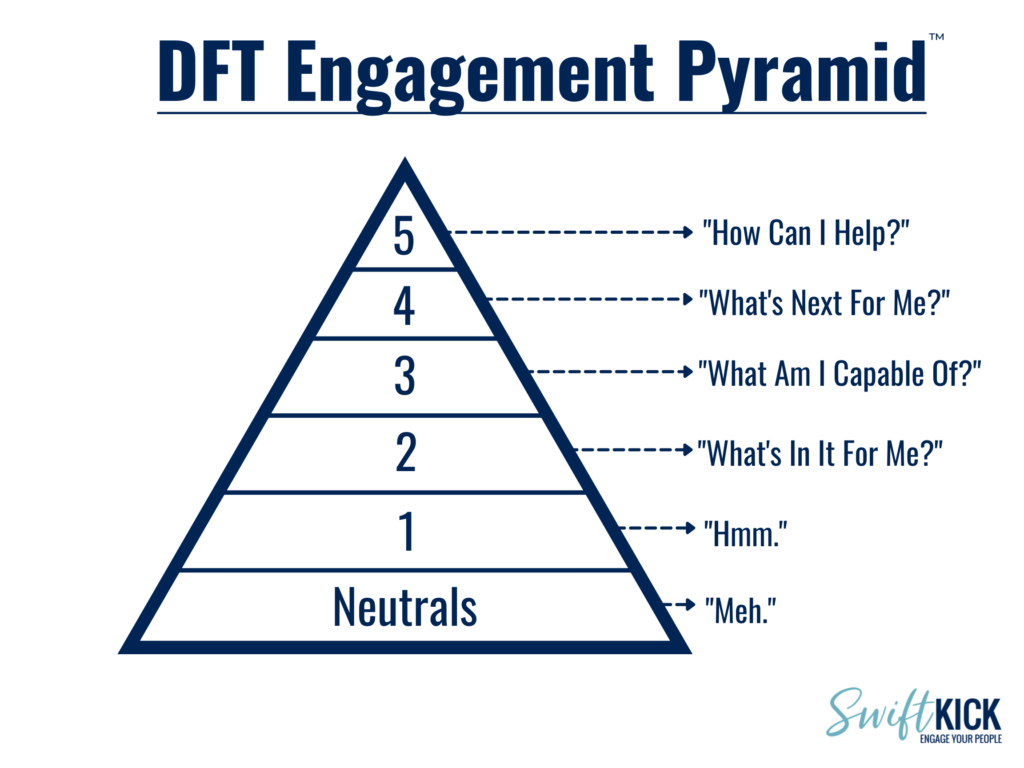1000 Free Hugs signs cost me $40… and that was with premium paper.
I used the signs for an event at a conference I was keynoting. The purpose was to create an engaging activity that connected people together and increased the energy of the conference. It took me about 30 minutes to set up the activity and pass out the free hug signs.
Compare that with a student leadership program I did for a university in Florida.
For this Florida group, They scheduled me to work with them for four hours, and they were only going to be six people in attendance. They paid me thousands of dollars for this program.
What’s the difference?
In Dance Floor Theory, we have a concept called the Engagement Pyramid, which breaks down the different levels of engagement within a community into six levels. At the bottom of the pyramid, you will find a group called “neutrals” – they are the least engaged people within a community. However, this group also makes up the largest percentage of people within a community. Then, at the top of the engagement pyramid, you will find a small group called “5s”, and they are the most engaged people within a community.
My free hugs activity was geared towards engaging the “neutrals” at the conference.
My leadership training in Florida was geared towards engaging the “5s” at that university.
When creating engaging activities for every level of the engagement pyramid, ensure that the amount of resources (money, time, effort, etc.) is proportional to the level of engagement. Meaning that most of your resources on a per-member basis should go towards the “5s” in your community, whereas “neutrals” should receive much less per member.
This doesn’t mean that you don’t engage in the “neutrals,” which sadly is what most community leaders fail at. This means that the activities you do with them don’t require a ton of resources. Save those resources for the 3s, 4s, and 5s.
Notice how I kept saying “per member basis?” The reason is you may spend a few thousand to engage only a few of your “5s” but also spend that same amount to engage several hundred “neutrals.”
Here Are A Few Steps You Can Take Within Your Community:
Understand The Engagement Pyramid:
Familiarize yourself with the different levels of engagement within your community, from “neutrals” to “5s”. This will help you identify which members require the most resources to engage and which ones require less.
Allocate Resources Effectively:
Once you understand the engagement pyramid, allocate your resources in a way proportional to the engagement level. This means focusing your efforts and resources on engaging the most engaged members while still engaging with those who are less engaged.
- Create engaging activities: Use engaging activities to connect with members of your community at different levels of the engagement pyramid. Be creative and try different approaches to see what works best for each group. In Dance Floor Theory, we used Blender Events as a low-cost way to engage “neutrals.”
- Measure success: Measure the success of your engagement efforts to identify what is working and what is not. Use metrics like attendance, participation, and feedback to evaluate the impact of your activities.
- Continuously improve: Use the data you gather to improve your engagement efforts over time. Identify areas where you can make improvements and implement changes to create a stronger, more engaged community.
The Engagement Pyramid is a powerful tool for community leaders looking to create engaging activities that connect people and increase energy. By understanding the different levels of engagement within a community, leaders can allocate resources effectively and efficiently. While engaging with all members is important, the amount of resources should be proportional to the level of engagement. The most amount of resources on a per-member basis should go towards the most engaged members, while those who are less engaged require less investment. By following this strategy, community leaders can create engaging activities that connect people at all levels of the engagement pyramid, building a stronger and more cohesive community.
